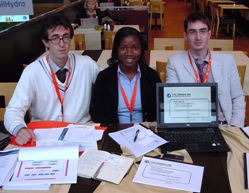
While we’re still young
Observant delegates may have noticed, around the exhibition or in the interstices of the congress, three businesslike young geologists in earnest conversation with such luminaries as Sir Mark Moody Stuart (Anglo-American), Robert Missotten (UNESCO) or Edmund Nickless. They were Dr Luca Micucci, Dr David Govoni (Italy) and Ms Eylvin Nkhonjera (University of Malawi – picture), representing a new international movement calling themselves the “Young Earth Scientists”.
Growing out of the IYPE opening ceremony in UNESCO and the highly successful student writing competition earlier this year, Young Earth Scientists are on a mission, and aim to hit the ground running. Micucci explains: “The problems facing us on this planet require long-term, largely geoscientific solutions. This generation is going to have to find those solutions, and put them into effect. We cannot afford to wait until we are in our fifties before we start to engage with politicians, social scientists and economists, whose help we will need. We need to start young. We need to start now.”
Just as they themselves will one day be grand professors and survey directors and IGC presidents, the Young Earth Scientists aim to build bridges with those who will become the opinion-forming politicians and economists of the future. Micucci: “Cultural change is what is needed, and this takes decades. We in Earth science know that an end point to progress - as it used to be defined at least - has been reached. The change in outlook within society will also require a change in science and the way it relates to politics.”
Stop Press:
As
Geoscientist went to press we learned that the YES Congress will be held in China. The organisers received a letter dated 28 August, from Wu Ganguo, President, China University of Geosciences (Beijing). The letter reads:
"As a leader of the university, I am so honored to agree and invite the First World Young Earth Scientists Congress 2009 to be held in our university----China University of Geosciences (Beijing).
"China University of Geosciences (Beijing) is the cradle of Chinese young earth scientist. During the 50 years’ practice, we have gained a reputation as academy for geology, developed a glorious motto as “Work Hard, Keep Modest, Flexibly Unit, and Pursue Progress”, attempting to be the leader in China’s geology education, and educated a lot of excellent earth scientists for our country even the world. Now we hope more and more young people will grow up and come to learn the geosciences, to understand our earth and protect it. Young Earth Scientists Congress will exclusively bring young scientists from different part of the world to discuss the future of geosciences and some of today’s challenges. It will establish strong networks of young professors and researchers, and must be a great help for the development of the earth sciences.
Young earth scientists represent the future and hope of our cause. We will try all best to support First young Earth Scientists Congress 2009.
I am confident that through our efforts together. We can have successful meeting for young earth scientists.
Wu Ganguo
President
China University of Geosciences (Beijing)